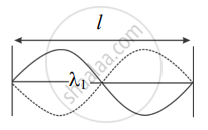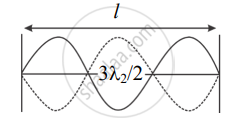Advertisements
Advertisements
Question
Show that even as well as odd harmonics are present as an overtone in modes of vibration of the string.
Solution
- Fundamental mode:
a. If a string is stretched between two rigid supports and is plucked at its centre, the string vibrates as shown in the figure.
b. It consists of an antinode formed at the centre and nodes at the two ends with one loop formed along its length.
c. If λ is the wavelength and l is the length of the string, then Length of loop = `λ/2 = l`
d. The frequency of vibrations of the string,
n = `"v"/λ = 1/(2l)sqrt("T"/"m")` ........`(∵ "v" = sqrt("T"/"m"))`
This is the lowest frequency with which the string can vibrate. It is the fundamental frequency of vibrations or the first harmonic. - For second mode or first overtone:
a. For first overtone or second harmonic, two loops are formed in this mode of vibrations.
b. There is a node at the centre of the string and at both ends.
c. If λ1 is the wavelength of vibrations, the length of one loop = `λ_1/2 = l/2`
∴ λ1 = l
d. Thus, the frequency of vibrations is given as
n1 = `1/λ_1sqrt("T"/"m")`
∴ n1 = `1/lsqrt("T"/"m")`
Comparing with fundamental frequency,
∴ n1 = 2n.
Thus the frequency of the first overtone or second harmonic is equal to twice the fundamental frequency. - For third mode or second overtone:
a. The string is made to vibrate in such a way that three loops are formed along the string as shown in the figure.
b. If λ2 is the wavelength, the length of one loop is `λ_2/2 = l/3`
∴ `λ_2 = (2l)/3`
c. Therefore the frequency of vibrations is `"n"_2 = 1/λ_2sqrt("T"/"m")`
∴ `"n"_2 = 3/(2l)sqrt("T"/"m")`
Comparing with fundamental frequency,
∴ n2 = 3n.
Thus the frequency of the second overtone or third harmonic is equal to thrice the fundamental frequency. - Similarly, for higher modes of vibrations of the string, the frequencies of vibrations are as 4n, 5n, 6n…pn. Thus even as well as odd harmonics are present as an overtone in modes of vibration of the string.
RELATED QUESTIONS
What are the forced vibrations and resonance?
Distinguish between forced vibrations and resonance.
Differentiate between free and forced vibrations.
A sonometer wire vibrates with three nodes and two antinodes, the corresponding mode of vibration is ...................
a) First overtone
b) Second overtone
c) Third overtane
d) Fourth overtone
Show that only odd harmonics are present in an air column vibrating in a pipe closed at one end.
A stretched wire emits a fundamental note of frequency 256 Hz. Keeping the stretching force constant and reducing the length of wire by 10 cm, the frequency becomes 320 Hz. Calculate the original length of wire.
State law of length.
What are forced vibrations?
A stretched wire 60 cm long is vibrating with its fundamental frequency of 256 Hz. If the length of the wire is decreased to 15 cm and the tension remains the same. Then the fundamental freuqency of the vibration of the wire will be ______.
